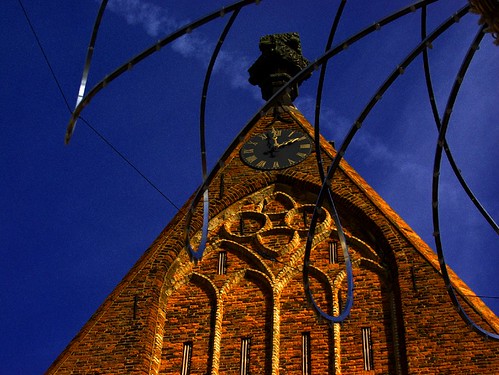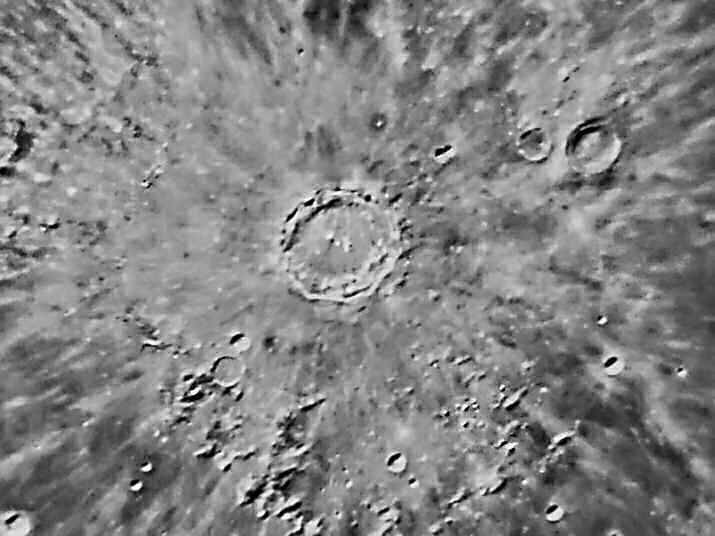
Previous episodes:
Last time we had gotten back as far as Thomas à Kempis. Thomas was educated as a copyist by the newly formed Brethren for the Common Life.

Nov 16 2008

Previous episodes:
Last time we had gotten back as far as Thomas à Kempis. Thomas was educated as a copyist by the newly formed Brethren for the Common Life.
Nov 09 2008

Previous episodes:
Desiderius Erasmus Roterodamus received his baccalaureate degree in theology in 1497 at the Collège de Montaigu in Paris, where he studied under the mentorship of Jan Standonck, after being mentored at Deventer by the German humanist Alexander Hegius. It seems we have strayed far from mathematics, but we shall return. This was the time of “men for all seasons.”
Nov 02 2008

Previous episodes:
We left off at Erasmus Reinhold, creator of the Prutenic Tables, based on the work of Nicolaus Copernicus, which were used to create the Gregorian calendar.
Reinhold’s Master of Arts degree in astronomy and astrophysics was earned at Wittenberg in 1535, as a student of Jacob Milich.
Not much is known of Milich. Plenty is known about his academic supervisors.
Oct 26 2008

The previous parts:
Frank Anderson, Malcolm Smiley, William Reid, Hyman Ettlinger, George Birkhoff, E. H. Moore, H. A. Newton, Michel Chasles, Simeon Poisson, Joseph Lagrange, Leonhard Euler, Johan Bernoulli, Jacob Bernoulli, Gottfried Lebniz, Christiaan Huygens. Fifteen generations of my mathematical ancestors.
Yes, there was a side trip to Pierre-Simon La Place and Jean d’Alembert that ended in a dead end. And it is true that the leap from Lagrange to Euler is tenuous, what with Lagrange being pretty much self-educated in mathematics. And it is also true that Huygens was more of an inventor, a maker of clocks and telescopes…and hence an astronomer.
Christiaan received a Master of the Liberal Arts degree from the University of Leiden in 1647 and a Doctor of Canon and Civil Law from Université d’Angers in 1655. His advisors were Frans van Schooten and Jan Stampioen.
Oct 19 2008
 Where were we?
Where were we?
(Part I: 250 years of history)
Oh, yes. Poisson, purportedly the most prolific mathematicians in terms as the number of publications, was a student of LaGrange and La Place at École Polytechnique in Paris.
LaPlace was a student of d’Alembert, but there we lose track of the lineage, since d’Alembert attended one of the colleges in the University Paris…which was decommissioned and dispersed during the French Revolution, so records are lost. Or because I am not a historian and I am not planning a trip to Paris to search for said records.
LaGrange, on the other hand, was a self-taught mathematician, mostly, whom Leonhard Euler chose to nurture to be his heir as Director of the Prussian Academy of Sciences in Berlin. Euler even left Berlin for St. Petersburg in 1766, happy to return now that Catherine was on the path to becoming the Great, so that LaGrange could begin his tenure. For that reason Euler is generally agreed to hold the position of LaGrange’s academic supervisor.
I identify with what LaGrange accomplished by teaching himself mathematics. While I had some wonderful teachers during my years as a student, the thing that they accomplished the most was to help me learn how to teach myself. I’ve always tried to remember that in my own teaching.
You’re wondering about the image to the left? Read on.
Oct 12 2008
 Being rather bored Thursday, while proctoring a midterm exam in Computer Literacy, a couple of my former professors came up in conversation, including my adviser, Frank Anderson. Frank studied the lattice characterization of C-Spaces, which won’t mean much to many, but the thing is that he studied in a field of mathematics called analysis. By the time I met him, he was an algebraist.
Being rather bored Thursday, while proctoring a midterm exam in Computer Literacy, a couple of my former professors came up in conversation, including my adviser, Frank Anderson. Frank studied the lattice characterization of C-Spaces, which won’t mean much to many, but the thing is that he studied in a field of mathematics called analysis. By the time I met him, he was an algebraist.
So I’m an algebraist as well, having studied the homology of torsion theories. My degree was awarded in 1981 at Oregon. Frank got his in 1954 at Iowa.
And there was time to keep going. Frank studied under Malcolm Smiley, who received his degree from Chicago in 1937, having studied Discontinuous Solutions for the Problem of Bolza in Parametric Form. Smiley studied under William Reid, who received his degree in 1929 from Texas, having studied the properties of solutions to infinite systems of ordinary differential equations with boundary conditions. His adviser at Texas was Hyman Ettlinger, who received his degree from Harvard in 1920, where he studied self-adjoint, second order linear systems of differential equations under George Birkhoff.
I perked up a bit, remembering that when I took my Russian exam in grad school, I had been given the task of translating a Russian version of Witt’s Theorem and having more than a cursory interest in the Birkhoff-Witt Theorem. So I plowed onward.
Oct 05 2008
The modern history of the Great Lakes region can be viewed as a progression of intensifying use of a vast natural resource. At first it was a matter of making use of the natural resources while avoiding its dangers.
Oct 05 2008
 My (almost) last batch of photos were taken in Debbie’s brother’s neighborhood. I had an hour or so on our last day in Los Angeles before we returned to the desert. So I took a walk through the neighborhood. And I took a camera with me.
My (almost) last batch of photos were taken in Debbie’s brother’s neighborhood. I had an hour or so on our last day in Los Angeles before we returned to the desert. So I took a walk through the neighborhood. And I took a camera with me.
Jim’s house is two blocks from the Los Angeles County Museum of Art (LACMA), which I wrote about before. And it’s also two blocks from the La Brea Tar Pits. Photos were not allowed inside LACMA…or I would be displaying one of a painting of The Death of Buddha.
But I did walk down to the grounds of the tar pits and got some shots. And I took more photos on the way back.
Sep 28 2008
Clyde McPhatter and the Drifters, ladies and gentleman, from 1953. This was their first hit. You may be more familiar with the cover versions by either Eddie Cochran (1959) or what’s his name…Elvis Presley (1956).
Life once again is dominated by, as Terry Pratchett called it, the “reflected-sound-of-underground-spirits”, aka echo-gnomics. It always distresses me when life becomes all about the money. But I live here and I live now. And there is next to no market in the political arena for knowledge, justice, stewardship of the planet and other things that would interest me more. Or any.
Money-grubbing sucks. Accumulation of money sucks the joy out of life. But that’s just my opinion.
Eymology Online is my friend, but don’t blame them for my rewrites.
Sep 28 2008
Physical Characteristics
The Great Lakes – Superior, Michigan, Huron, Erie and Ontario – span more than 750 miles from west to east and are an important part of the physical and cultural heritage of North America.  The complexity and magnitude of the Great Lakes water system is difficult to grasp, even for those who live within the basin.
The complexity and magnitude of the Great Lakes water system is difficult to grasp, even for those who live within the basin.
The lakes cover a total of 294,000 square miles and contain about 5,500 cubic miles of water. The Great Lakes are the largest collection of fresh, surface water on earth, containing roughly 18 percent of the world supply. Only the polar ice caps contain more fresh water. Although part of a single system, each lake is different.
Sep 14 2008
 From San Diego we returned to the desert for a few days before heading for LA to visit with Debbie’s brother and his wife…though we didn’t see much of her because of “family concerns.” We arrived on the evening of the opening of the Olympic Games. It was a colorful production.
From San Diego we returned to the desert for a few days before heading for LA to visit with Debbie’s brother and his wife…though we didn’t see much of her because of “family concerns.” We arrived on the evening of the opening of the Olympic Games. It was a colorful production.
On Saturday we walked a couple of blocks to LACMA (the Los Angeles County Museum of Art), which shares a park with the LA Brea Tar Pits (coming up later). We saw The Age of Imagination, which closes today. Here is some of it for you.
The colors were mostly so subtle, while at the same time being so exquisitely laid down. It am astounded that these paintings were all painted in only one layer.
On Sunday we went to the Aquarium of the Pacific in Long Beach.
Ooooooh! Ahhhhhh! The colors.
Aug 31 2008
Random thoughts coagulate around a not-so-random natural event named Gustav.
Jim Morrison’s last song:
For some reason it popped into my head this morning. Let’s hope the next few days are not also New Orleans’ last song…or swan song.
We delve into the Online Etymology dictionary:
swan
An Old English word from the proto-Germanic *swanaz (cf. Old Saxon swan, Old Norse svanr, Middle Dutch swane, which became the Dutch zwaan; Old High German swan became the German Schwan), probably literally “the singing bird,” from the proto-Indo-European base *swon-/*swen- “to sing, make sound” (see sound (n.1)); thus related to the Old English geswin “melody, song” and swinsian “to make melody.”
Intermission: Geswin…Gershwin…melody song. Louis and Ella…on the inside.